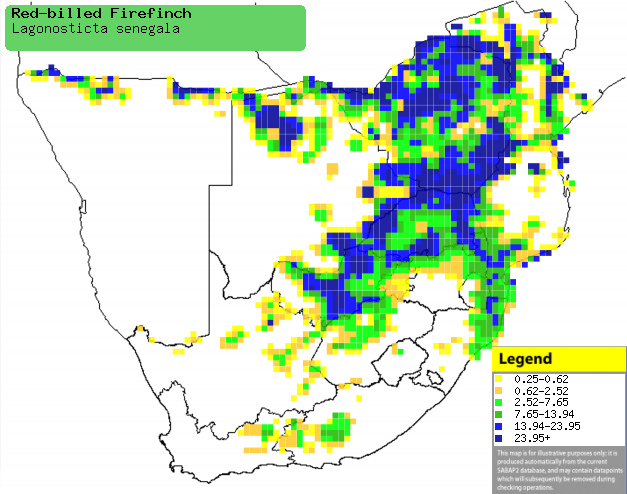|
Lagonosticta senegala
(Red-billed firefinch)
Rooibekvuurvinkie [Afrikaans]; Borane (also aplied to other
waxbills and firefinches) [South Sotho]; Xidzingirhi (generic term for
firefinches and waxbills; also applied to Ground woodpecker [check])
[Tsonga]; Vuurvinkje [Dutch]; Amarante du Sénégal [French];
Senegal-amarant, Amarant [German]; Peito-de-fogo-de-bico-vermelho
[Portuguese]
Life
> Eukaryotes >
Opisthokonta
> Metazoa (animals) >
Bilateria >
Deuterostomia > Chordata >
Craniata > Vertebrata (vertebrates) > Gnathostomata (jawed
vertebrates) > Teleostomi (teleost fish) > Osteichthyes (bony fish) > Class:
Sarcopterygii (lobe-finned
fish) > Stegocephalia (terrestrial
vertebrates) > Tetrapoda
(four-legged vertebrates) > Reptiliomorpha > Amniota >
Reptilia (reptiles) >
Romeriida > Diapsida > Archosauromorpha > Archosauria >
Dinosauria
(dinosaurs) > Saurischia > Theropoda (bipedal predatory dinosaurs) >
Coelurosauria > Maniraptora >Aves
(birds) > Order: Passeriformes
> Family: Estrildidae
Distribution and habitat
Occurs across much of sub-Saharan Africa, excluding the
Lowland forest in and around the DRC, from Senegal to Somalia south to southern
Africa. Here it is common from Zimbabwe and Mozambique west to northern Botswana
and Namibia and south to north-eastern and northern South Africa, while more
scarce in the Northern, Eastern and Western Cape. It generally prefers rank
grass and thickets with patches of bare soil, especially in moist woodland and
Acacia savanna, also occupying cultivated fields and thickets near water.
|
 |
|
Distribution of Red-billed firefinch in southern
Africa, based on statistical smoothing of the records from first SA Bird
Atlas Project (©
Animal Demography unit, University of
Cape Town; smoothing by Birgit Erni and Francesca Little). Colours range
from dark blue (most common) through to yellow (least common).
See here for the latest distribution
from the SABAP2. |
Predators and parasites
It has been recorded as prey of
chameleons and
snakes, as
well as being a host of the protozoan parasite Trypanosoma everetti.
Food
It mainly eats grass seeds taken from the ground,
supplemented with insects, often joining mixed-species foraging flocks along
with other seedeaters. The following food items have been recorded
in its diet:
- Grass seeds
- Echinochloa colona (Jungle rice)
- Setaria (bristle grasses)
- Urochloa (signal grasses)
- Panicum (Guinea grasses)
- Chloris
- Digitaria (finger grasses)
- Eleusine (goose grasses)
- Arthropods
Breeding
- The nest is built solely by the male, consisting of a ball-shaped
structure with a side entrance, made of dry grass blades with an inner shell
of grass inflorescences, lined with feathers. It is typically placed in
plant debris beneath a tree or bush, alternatively in a thatch roof, hedge
or hole in a wall.
- Egg-laying season is almost year-round, peaking from December-June.
- It lays 2-6 eggs, which are incubated by both sexes for about 11-12
days.
- The chicks are fed by both parents, leaving the nest after about 17-20
days and becoming fully independent approximately 2-4 weeks later.
Threats
Not threatened.
References
-
Hockey PAR, Dean WRJ and Ryan PG 2005. Roberts
- Birds of southern Africa, VIIth ed. The Trustees of the John Voelcker
Bird Book Fund, Cape Town.
|
